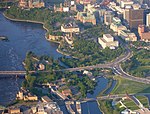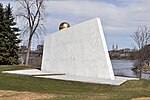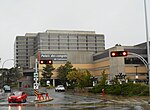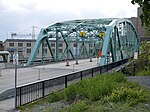Portage Bridge
1973 establishments in Ontario1973 establishments in QuebecBridges completed in 1973Bridges in GatineauBridges in Ottawa ... and 4 more
Bridges over the Ottawa RiverNational Capital CommissionRoad bridges in OntarioRoad bridges in Quebec

The Portage Bridge (French: Pont du Portage) crosses the Ottawa River just down-river from the Chaudière Bridge, joining the communities of Gatineau, Quebec and Ottawa, Ontario. It links Laurier Street and Alexandre-Taché Boulevard in the Hull sector of Gatineau and Wellington Street at the Garden of the Provinces and Territories in Ottawa, crossing Victoria Island and the former Philemon Island on the way. The bridge was built by the National Capital Commission in 1973 and expanded in 1988. The bridge is named after the historic Portage Trail around the Chaudière Falls and Rapids which ended near the present location of the bridge.
Excerpt from the Wikipedia article Portage Bridge (License: CC BY-SA 3.0, Authors, Images).Portage Bridge
Portage Bridge cycle track, (Old) Ottawa Somerset
Geographical coordinates (GPS) Address External links Nearby Places Show on map
Geographical coordinates (GPS)
| Latitude | Longitude |
|---|---|
| N 45.422222222222 ° | E -75.713611111111 ° |
Address
Pont du Portage
Portage Bridge cycle track
K1A 0M8 (Old) Ottawa, Somerset
Ontario, Canada
Open on Google Maps







